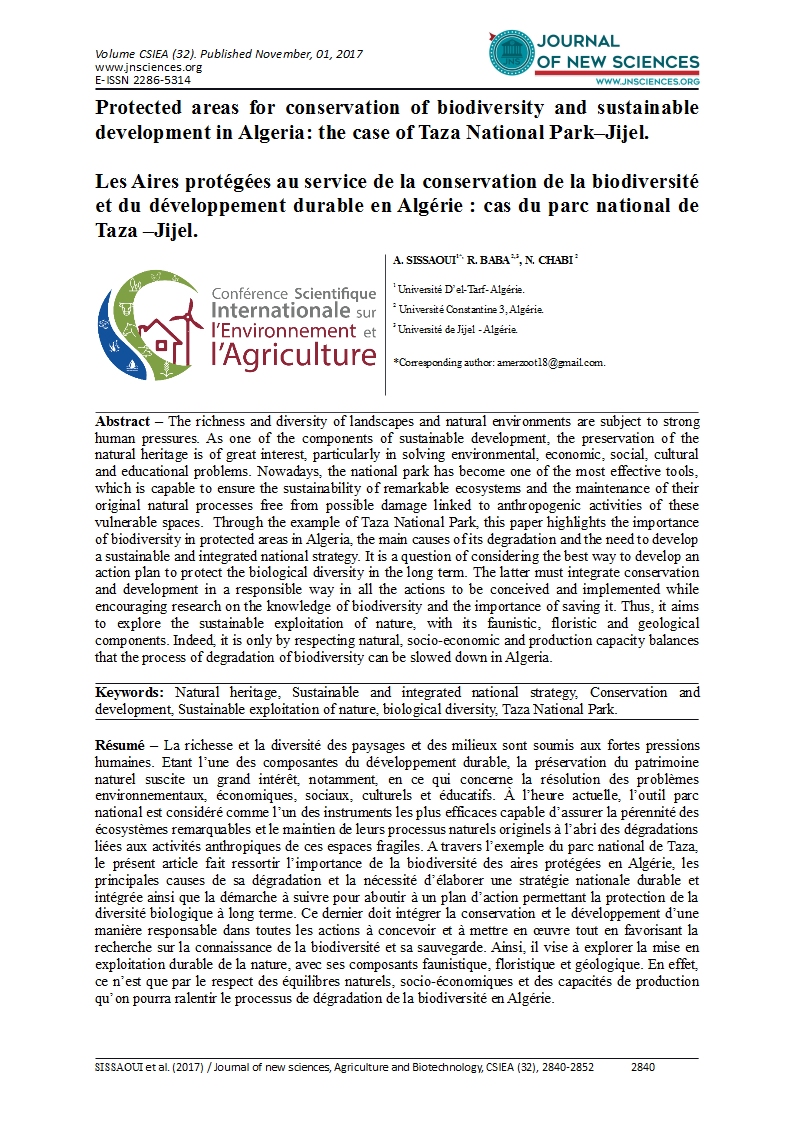

- Category: Volume spécial (Conférence CSIEA 2017)
- Hits: 11642
Protected areas for conservation of biodiversity and sustainable development in Algeria: the case of Taza National Park–Jijel.
Les Aires protégées au service de la conservation de la biodiversité et du développement durable en Algérie : cas du parc national de Taza –Jijel.
|
|
A. SISSAOUI1*, R. BABA 2,3, N. CHABI 2 1 Université D’el-Tarf- Algérie. 2 Université Constantine 3, Algérie. 3 Université de Jijel - Algérie. |
Abstract – The richness and diversity of landscapes and natural environments are subject to strong human pressures. As one of the components of sustainable development, the preservation of the natural heritage is of great interest, particularly in solving environmental, economic, social, cultural and educational problems. Nowadays, the national park has become one of the most effective tools, which is capable to ensure the sustainability of remarkable ecosystems and the maintenance of their original natural processes free from possible damage linked to anthropogenic activities of these vulnerable spaces. Through the example of Taza National Park, this paper highlights the importance of biodiversity in protected areas in Algeria, the main causes of its degradation and the need to develop a sustainable and integrated national strategy. It is a question of considering the best way to develop an action plan to protect the biological diversity in the long term. The latter must integrate conservation and development in a responsible way in all the actions to be conceived and implemented while encouraging research on the knowledge of biodiversity and the importance of saving it. Thus, it aims to explore the sustainable exploitation of nature, with its faunistic, floristic and geological components. Indeed, it is only by respecting natural, socio-economic and production capacity balances that the process of degradation of biodiversity can be slowed down in Algeria.
Keywords: Natural heritage, Sustainable and integrated national strategy, Conservation and development, Sustainable exploitation of nature, biological diversity, Taza National Park.
Résumé – La richesse et la diversité des paysages et des milieux sont soumis aux fortes pressions humaines. Etant l’une des composantes du développement durable, la préservation du patrimoine naturel suscite un grand intérêt, notamment, en ce qui concerne la résolution des problèmes environnementaux, économiques, sociaux, culturels et éducatifs. À l’heure actuelle, l’outil parc national est considéré comme l’un des instruments les plus efficaces capable d’assurer la pérennité des écosystèmes remarquables et le maintien de leurs processus naturels originels à l’abri des dégradations liées aux activités anthropiques de ces espaces fragiles. A travers l’exemple du parc national de Taza, le présent article fait ressortir l’importance de la biodiversité des aires protégées en Algérie, les principales causes de sa dégradation et la nécessité d’élaborer une stratégie nationale durable et intégrée ainsi que la démarche à suivre pour aboutir à un plan d’action permettant la protection de la diversité biologique à long terme. Ce dernier doit intégrer la conservation et le développement d’une manière responsable dans toutes les actions à concevoir et à mettre en œuvre tout en favorisant la recherche sur la connaissance de la biodiversité et sa sauvegarde. Ainsi, il vise à explorer la mise en exploitation durable de la nature, avec ses composants faunistique, floristique et géologique. En effet, ce n’est que par le respect des équilibres naturels, socio-économiques et des capacités de production qu’on pourra ralentir le processus de dégradation de la biodiversité en Algérie.
Mots clés : Patrimoine naturel, Diversité biologique, Stratégie nationale intégrée, Conservation et développement, Exploitation durable de la nature, Parc national de Taza.

